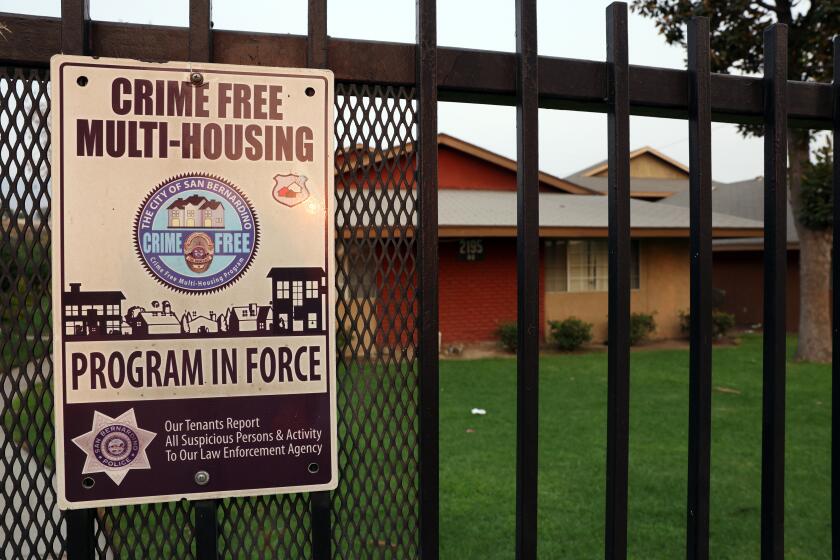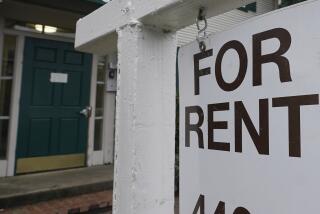Black and Latino renters face eviction, exclusion amid police crackdowns in California
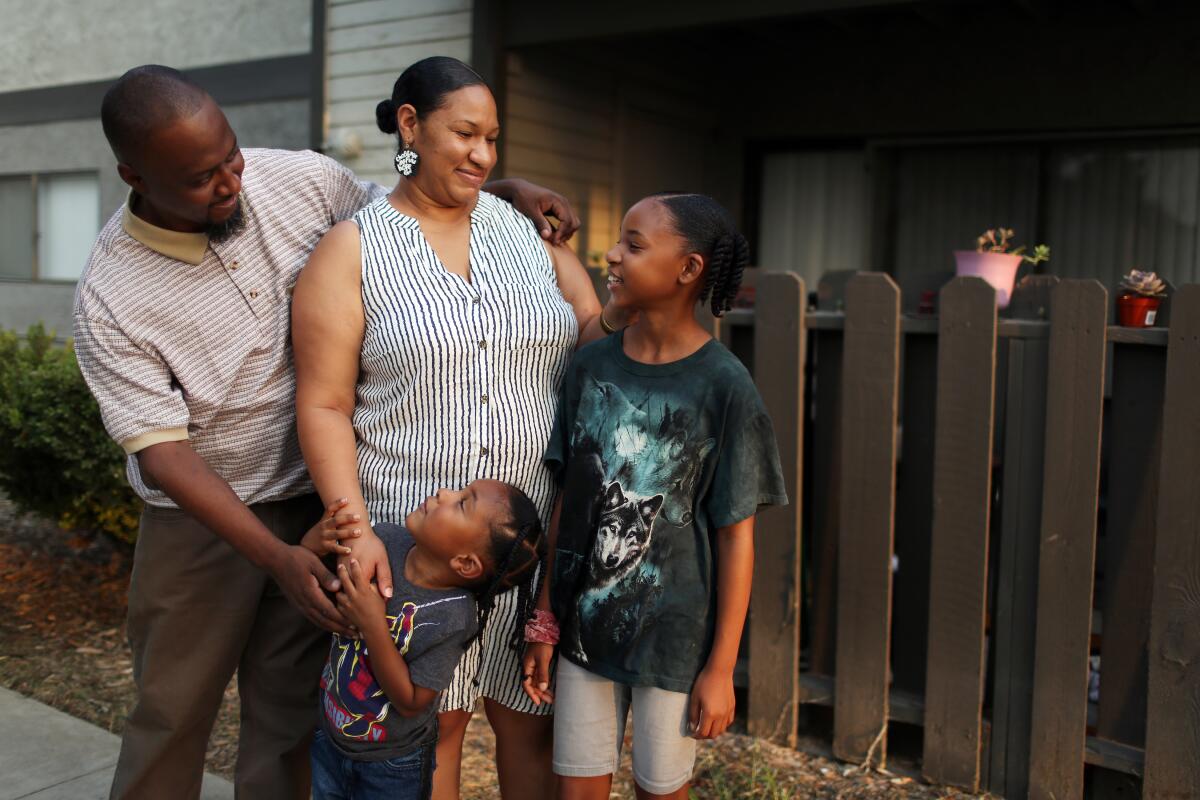
- Share via
Three years after his release from prison following a cocaine dealing conviction, Terrance Stewart was accepted to UC Riverside and began searching for a place to live near campus with his wife and 3-month-old daughter.
He couldn’t find one. Facing rejection after rejection, Stewart started to realize that posted around the apartment complexes he visited were gray signs with the stenciled outlines of three homes. The logos, he later learned, meant those landlords took part in a police program that trains them how to refuse tenants with criminal histories.
“It just made my world shrink,” Stewart said.
Kept out of Riverside and neighboring cities, Stewart’s family rented a room in a Lake Elsinore home, a 90-minute bus ride from campus.
Stewart didn’t know it at the time, but he was up against “crime-free housing,” a collection of policies that have expanded the power of the police to decide who can and can’t live in more than a thousand cities across the country.
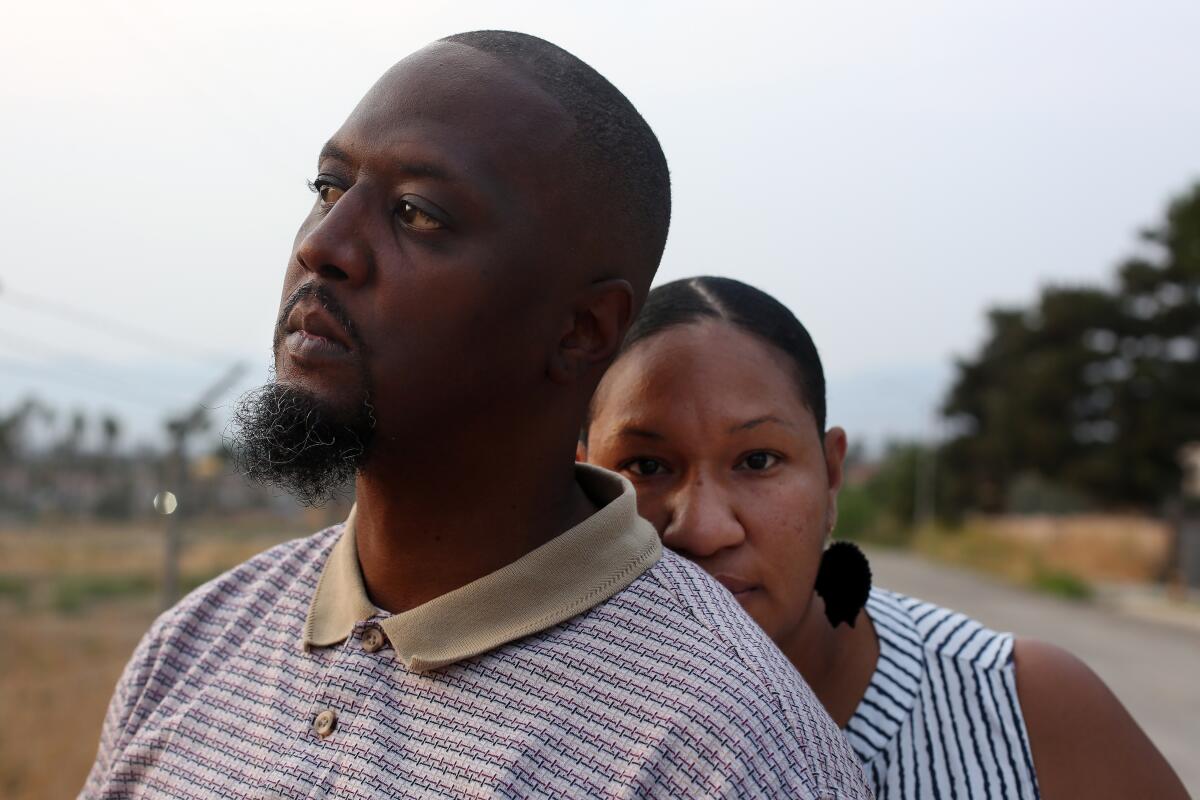
The programs approved by cities vary, but are aimed at empowering landlords to evict or exclude tenants who have had brushes with law enforcement.
Some cities have taken a strict approach, adopting laws requiring the eviction of tenants accused of breaking the law. Others provide police training for landlords on criminal background checks and anticrime lease provisions.
The rules draw strong support from police, prosecutors and politicians who contend that they help keep neighborhoods safe, especially in areas with drug- and gang-related problems.
But a Times investigation has found the programs have disproportionately affected Black and Latino residents in California, making it harder for them to rent apartments and leaving them at greater risk of eviction.
A map of the programs’ expansion has left a distinct pattern: As Black and Latino people moved to the suburbs in search of safer neighborhoods and cheaper housing, crime-free housing policies often came soon after.
Overall, at least 147 cities and counties in California have enacted a crime-free housing law or advertise crime-free housing training for landlords, The Times found, more than a quarter of all the local governments in the state.
Among the 20 California cities with the largest increases in Black residents since 1990, 85% have approved crime-free housing policies, a Times data analysis found. Such communities include the fast-growing suburbs of Lancaster, Moreno Valley and Victorville. For communities that saw the largest increases in Latino population, 75% have approved the policies, including Fresno, Bakersfield and Ontario.
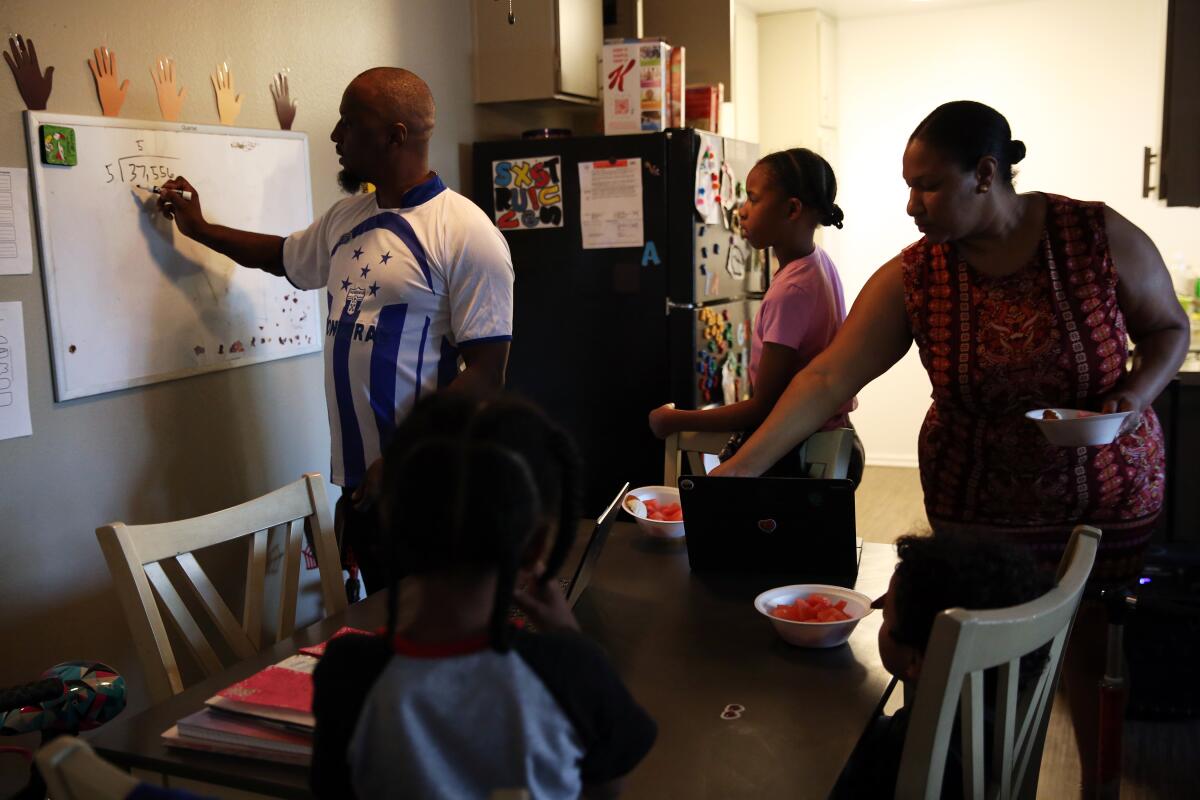
Black, Latino and other tenants of color also have been more likely to face eviction under crime-free housing than white tenants.
The Times reviewed five years of eviction data for one program that covers four of California’s largest cities: Los Angeles, Long Beach, Oakland and Sacramento. Nearly 80% of those targeted for eviction from 2015 through 2019 were not white. In Oakland, Black tenants faced eviction at twice their share of the city’s renter population.
Though descriptions of crime-free housing programs do not mention race, some supporters have used disturbing and thinly coded racist language to justify them. One city councilman in Hesperia said the purpose of his city’s ordinance was “to correct a demographical problem with people that are committing crimes in this community.”
A resident at one raucous City Council meeting in Hemet cited “some new elements that have moved into our town” in pushing for the rules.
Criminals are referred to as “weeds” and “the two-legged urban predator” in a training manual used by many police departments in California.
Again and again, the specter of rising crime rates has been inaccurately used as justification for the housing policies. In some suburbs, including Antioch, Hemet and Hesperia, police departments pursued crime-free housing efforts when crime rates were actually stable or falling. What was increasing in those communities was their Black and Latino populations.
To measure the relationship between crime-free policies and shifting demographics, The Times analyzed U.S. Census data.
The programs have continued to flourish despite legal crackdowns.
The U.S. Department of Justice in December sued Hesperia and the San Bernardino County Sheriff’s Department, contending that they intentionally singled out Black and Latino tenants for enforcement.
In 2013, the cities of Lancaster and Palmdale were found to have teamed with the Los Angeles County Sheriff’s Department to drive out Black residents living in subsidized housing, according to a Justice Department investigation.
Still, backers argue the programs can help the community if done right.
In Los Angeles, enforcement of such policies has been concentrated in Black and Latino neighborhoods in South Los Angeles. City Atty. Mike Feuer said residents appreciate the effort to address chronic crime problems.
“The people who live in these communities who are African American and Latino, they deserve safety, too. Just like people who live in more affluent neighborhoods who are white deserve that safety,” Feuer said.
Nevertheless, some experts say the increasing involvement of law enforcement in previously private dealings between landlords and tenants is leading to devastating results for communities of color — just as many housing policies have done in the past.
Segregationist-era practices like mortgage redlining and racial covenants in property deeds prevented Black residents from living in certain neighborhoods.
Deborah Archer, a co-director at the Center on Race, Inequality and the Law at New York University, believes the proliferation of crime-free housing programs represents a new form of government-sponsored racism akin to those efforts.
“We are seeing an increasing meshing of policing and housing policy in a way that is going to allow the racial biases of the policing system to infiltrate housing with really detrimental impacts for Black and brown communities,” said Archer, who has studied crime-free housing programs. “It is going to help facilitate and entrench racial segregation in housing.”

The Bay Area suburb of Antioch, in the early 2000s, had housing to spare. The mortgage foreclosure crisis had turned new developments into ghost towns of suddenly unaffordable homes. To fill them, homeowners began renting them out to people receiving federal Section 8 housing assistance, many of whom were Black.
The promise of good schools, open spaces and more affordable housing drew so many people from Oakland and other cities that Antioch has experienced a bigger influx of Black residents than any other Northern California community over the past three decades.
But Antioch’s existing residents, especially in its whiter, wealthier enclaves, began complaining about violence and blight they said was accompanying the influx of low-income renters — though the city’s crime statistics did not bear out those claims.
Nevertheless, the city responded in 2006 by creating a special police unit that investigated Section 8 households. Police officers repeatedly warned landlords that they could be held legally responsible for their tenants’ actions, a tactic that often leads to evictions.
Two years later, civil rights attorneys filed suit, alleging that the Police Department systematically targeted Black renters, including those who reported domestic violence incidents. To settle the case, Antioch officials pledged to not focus on tenants’ race or Section 8 status in their policing efforts.
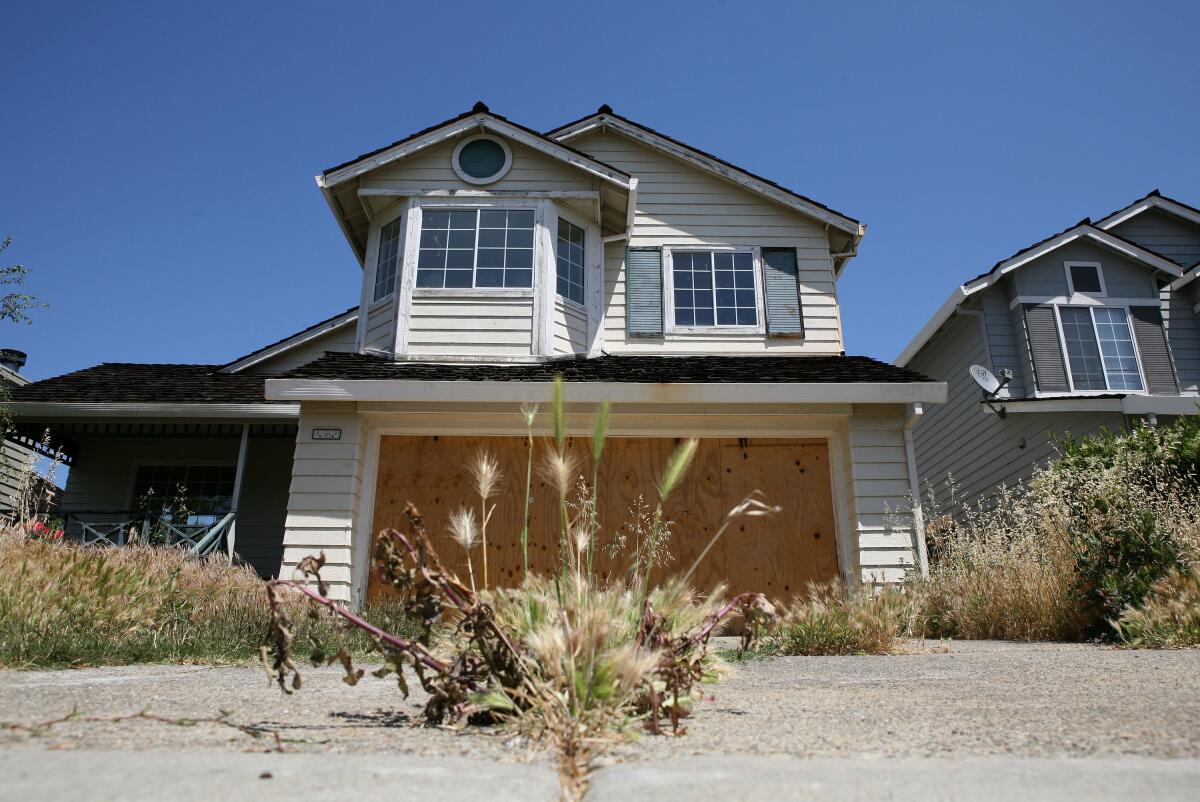
“It’s a relief that this is finally resolved and that people will be watching to make sure Antioch doesn’t try to push out any other families like mine,” said Santeya Williams, an Antioch tenant and plaintiff in the case, when the settlement was announced.
Antioch isn’t alone. Crime-free housing policies have spread throughout California, especially in diversifying communities. The programs first came about in the late 1980s when crime rates were surging, viewed as an effective way to target enforcement on crime-ridden hot spots like specific apartment complexes.
A go-to training manual was first developed in 1992 by a Mesa, Ariz., police officer who later founded an organization, the International Crime Free Assn., to promote the policies. The guidelines ranged from gardening tips to detailed eviction explainers. Police instructed landlords to increase lighting and keep trees trimmed. And officers also showed them how to do criminal background checks and fast-track evictions by inserting anticrime lease terms in rent contracts.
Some cities have enacted laws that go beyond what the manual recommends. One way has been to grant police and code enforcement officers the authority to fine landlords and push them to evict tenants — typically following incidents involving drugs or weapons. Today, nearly 2,000 cities in the United States and elsewhere have crime-free housing policies, according to an estimate from the International Crime Free Assn.
The efforts continued to expand even as crime rates stabilized or dropped over the past three decades. As in Antioch, some areas with rising Black and Latino populations carried out crime-free housing campaigns marred by veiled racist rhetoric and fear mongering.
In the Los Angeles suburb of Lancaster, which has seen California’s largest increase in Black residents since 1990, city leaders joined with deputies from the Los Angeles County Sheriff’s Department to crack down on predominantly Black Section 8 voucher holders.
With guns drawn and decked out in SWAT team armor, deputies would appear at tenants’ doors for what were supposed to be administrative compliance visits.
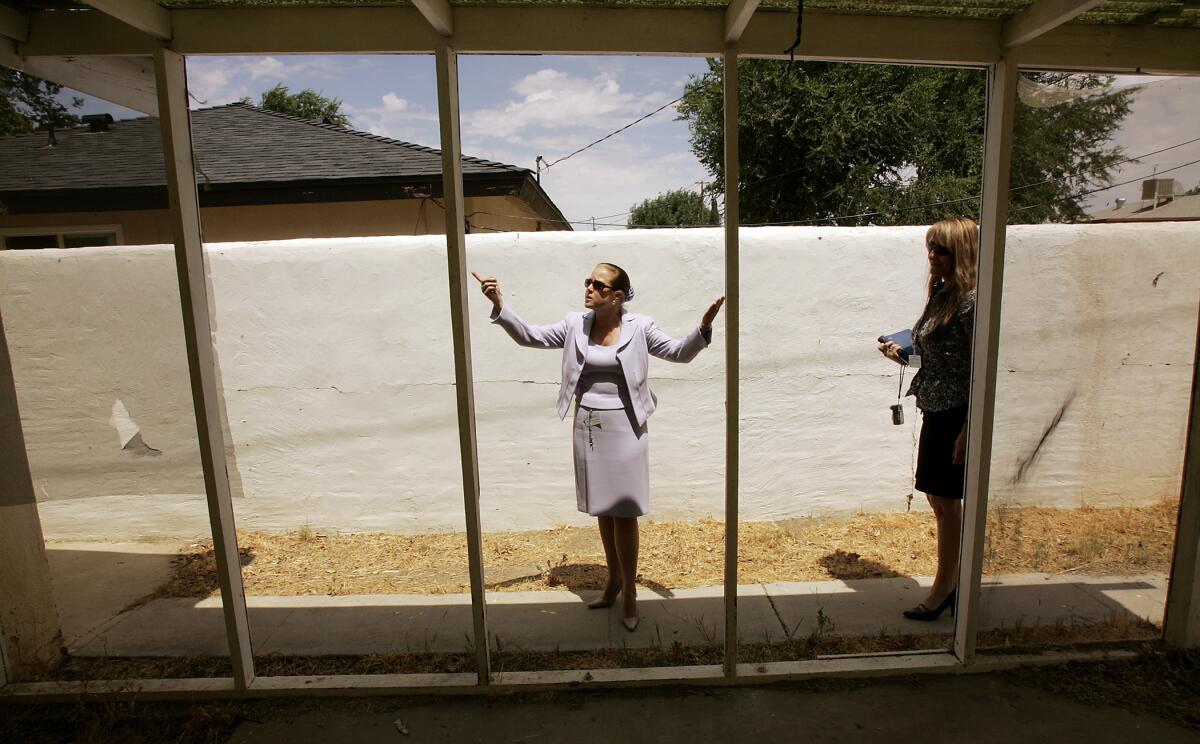
In 2008, Lancaster took further measures, passing a crime-free housing law that threatened landlords with fines if they didn’t evict tenants following more than five police calls to an apartment complex.
The National Assn. for the Advancement of Colored People sued over the law and similar practices in Lancaster and neighboring Palmdale, sparking the Justice Department’s investigation.
Federal officials concluded that police were motivated by unsubstantiated and racist beliefs that Black tenants on housing assistance were gang members bringing crime into the Antelope Valley.
In another city, a crime-free housing program was promoted on a massive tank-like vehicle at civic events. Turned into a mobile billboard by police offers in the Riverside County city of Hemet, the vehicle had been previously used by the department’s SWAT team.
As in Antioch, mortgage foreclosures had hit Hemet hard. The headline in a 2010 Times article highlighting residents’ complaints said that the city had turned “From bucolic bliss to ‘gated ghetto.’”
At the time, violent crime in Hemet was actually lower than it had been five years earlier.
What had changed was Hemet’s demographics. Since 1990, Hemet’s population has more than doubled to 84,000, with the number of Black residents increasing from fewer than 300 to just over 6,000. The Latino population has increased by more than 30,000.
The issues came to a head at City Council meetings in summer 2012, called in response to Facebook groups spreading inaccurate rumors that officials were dumping probationers in Hemet, according to an account in the Riverside Press-Enterprise. Outside the meetings, vendors hawked shirts that read “Take Back Hemet.”
“We’ve kicked this can of tolerance 25 years down the road,” business owner Don Digby said at one meeting, after noting that one of his employee’s cars had been stolen. “And we need to become intolerant. That’s what it’s going to take.” The crowd responded with sustained applause.
The crime-free housing law passed the City Council soon after.
A similar debate occurred a few years later in Hesperia, another high desert suburb that had experienced sharp Black and Latino population increases. Despite warnings from fair housing, landlord and criminal justice groups that its crime-free housing ordinance was illegal, the city barreled ahead.
Councilman Bill Holland said the purpose of the law was to weed out criminal outsiders the same way “you would call an exterminator to kill roaches.”
Enforcement was severe. In one case, a woman and her three children were evicted from their apartment after she called 911 to report that her husband was beating her with a television cable, a federal Department of Housing and Urban Development investigation found.
Black tenants were almost four times as likely as white renters to be evicted under Hesperia’s law, the investigation determined.
In court filings, the city and police have denied the Justice Department’s allegations of racial discrimination.
Timothy Zehring, the founder of the International Crime Free Assn., declined to be interviewed.
Zehring’s manual, which is still widely used in California, emphasizes that racial discrimination is illegal. But it also notes that those with criminal histories do not have special protection under federal law and can legally be turned away. The manual advises that a strategy for avoiding lawsuits is for landlords to be careful with what they say when screening tenants.
“Discrimination suits are filed when managers say too much!” the manual says.
The manual also includes the references to criminals as “weeds” and “the two-legged urban predator.” The association’s logo is what Stewart saw on apartment buildings while searching in Riverside.
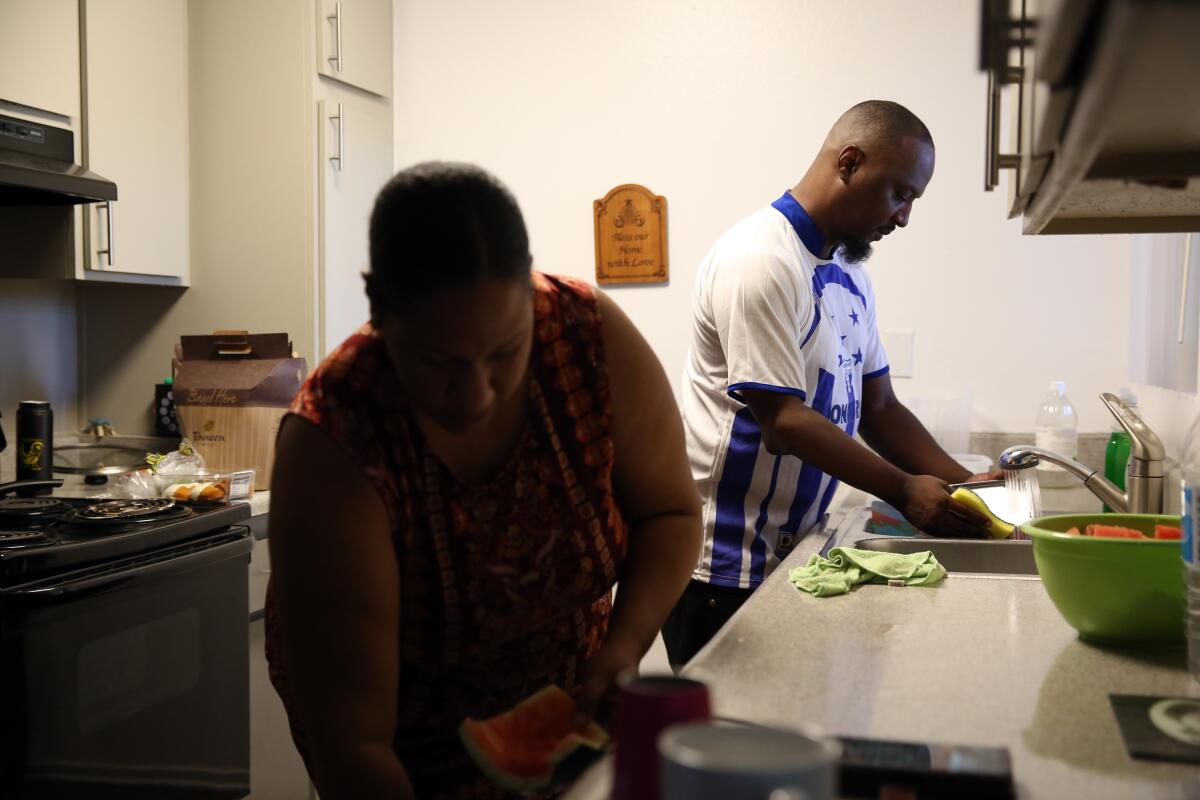
Stewart’s room in Lake Elsinore was so small it didn’t have a stove. When he returned home to cook dinner after classes at UC Riverside, Stewart would fry fish with a waffle iron.
Ultimately, Stewart, who is Black, was able to get into student housing. But five years later, when he graduated with a master’s degree in higher education and policy administration, Stewart again found his family blocked from apartments in Riverside because of his then nearly decade-old drug conviction.
By then, Stewart and his wife had an infant son along with their daughter. They ended up in a rundown apartment outside the city before a work connection found him a better place. That experience scarred him so much that Stewart still keeps photos on his cellphone of giant rats he trapped in the old complex.
“I became a man and started taking care of my family and one of the hardest things has been housing,” said Stewart, now 40 and working at Californians for Safety and Justice, a criminal justice reform organization. “It wasn’t because I didn’t have the money. Or I didn’t have good credit. Or I didn’t have the education. It was because I had this past conviction.”
The school dedicated to teaching children about environmental sustainability faced crime problems soon after it opened in Los Angeles’ Harbor Gateway neighborhood in 2013.
Across the street from the Environmental Charter Middle School were apartment buildings filled with tenants who often targeted the school.
Tenants threatened the boys with violence and harassed the girls, said Alison Diaz, then the school’s executive director. The tenants also regularly broke into the school. One time, during school hours, a stray bullet struck the building, pockmarking the exterior.
Diaz turned to the city attorney’s office for help. And in 2015, the city helped engineer the apartments’ sale through one of its crime-free housing programs, and then kept tabs on the new owners. Within a year, Diaz said, the problems went away, providing immense relief to parents.
“They wanted their kids to be safe,” Diaz said. “Everybody wants their children to be safe.”
Supporters of crime-free housing point to situations like these as evidence that the programs work. The policies, they say, ensure that all residents no matter their racial background can live without fear of drugs or violence.
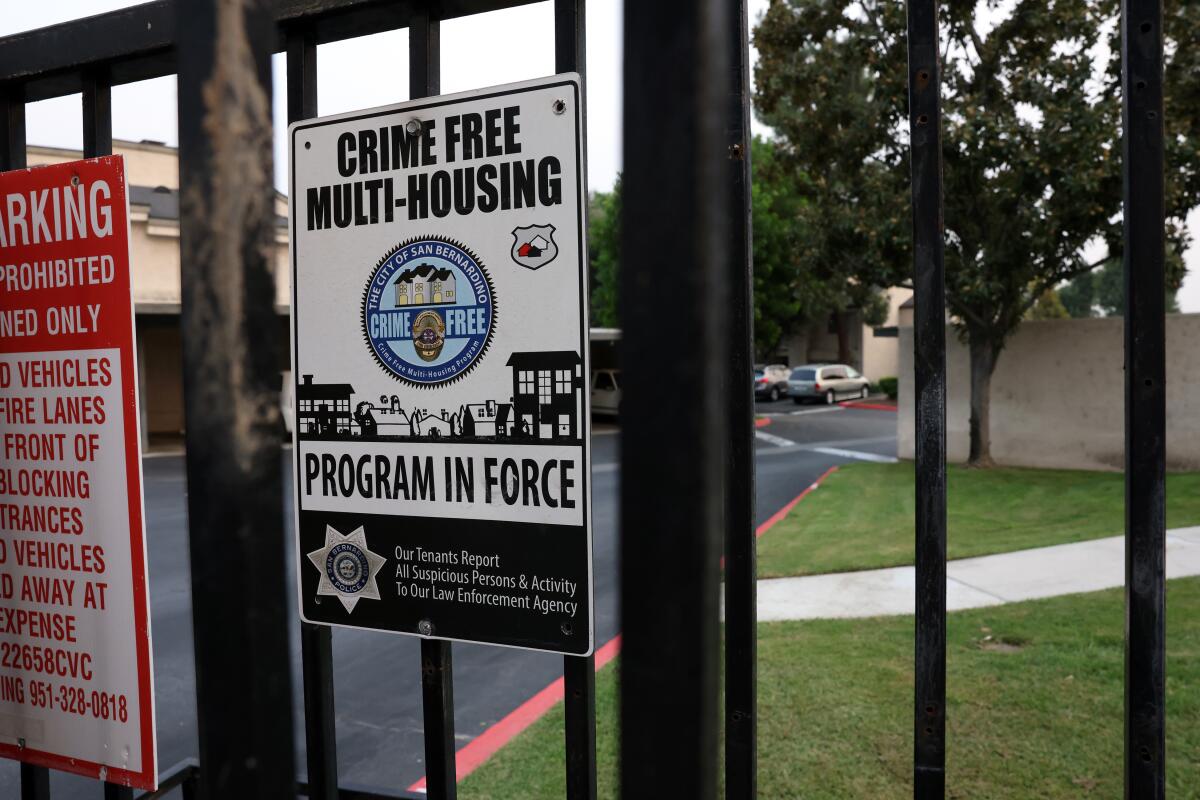
Greg Jones, who runs the program for the San Bernardino County Sheriff’s Department, tells the story of one complex in the city of San Bernardino that upgraded its security system, cut hedges and redid lighting.
“It’s more family friendly,” Jones said. “They’ve had more individuals requesting to become tenants because it’s a safe environment.”
Jones called the program an example of community-oriented policing that helps identify circumstances that lead to crime and disorder.
Currently, police departments in at least 35 local governments in California, including Fremont, Davis and San Diego, advertise crime-free housing training for landlords.
An additional 112 cities and counties in the state, according to the Times review of municipal codes, have passed versions of crime-free housing laws that allow police and code enforcement to sanction landlords and often urge them to evict tenants — usually following drug or gang incidents. In the Bay Area suburb of Fairfield, the city can fine landlords up to $1,000 per incident if they allow tenants to use drugs or commit acts of prostitution in an apartment.
In Los Angeles, the programs target properties that are known havens for those committing crimes, prosecutors say, like the ones outside the middle school in Harbor Gateway. The city’s enforcement of crime-free housing efforts, however, is concentrated in certain neighborhoods.
Of the nearly 100 cases filed by the city between 2013 and 2018 under one program, three-quarters were in South L.A., according to research by The Anti-Eviction Mapping Project, Los Angeles.
Feuer, the city attorney, said the number of cases in South L.A. reflects its acute dangers of drug and gang violence. If the city attorney’s office was not taking action, he said, it could be rightfully accused of abandoning those neighborhoods.
The San Bernardino County Sheriff’s Department and the L.A. city attorney’s office provided anecdotal evidence that their policies had led to fewer police calls at properties where they took action. Neither has done an analysis to determine the overall effectiveness of the programs or whether they are racially biased.

Not long after taking office in 2018, Adelanto City Councilwoman Stevevonna Evans came across the city’s crime-free housing law. She couldn’t believe it.
“The verbiage is very clear,” Evans said. “If you are accused of a crime, you have to be evicted.”
Fearing Adelanto residents would fall prey to the kind of prejudicial practices that plagued nearby Hesperia, Evans spearheaded a campaign to get rid of the policy. The law was repealed by the City Council earlier this year.
“I would hope that more cities would follow suit,” Evans said. “It’s just so discriminatory.”
Increasingly, elected officials and regulatory agencies are coming to similar conclusions. But efforts to roll back crime-free housing policies aren’t always resulting in meaningful changes.
In 2016, HUD recommended that cities repeal their crime-free housing programs to avoid running afoul of fair housing laws. Two years ago, California legislators banned police response to domestic violence or emergency medical calls as a basis for evictions.
In January, the California Department of Fair Employment and Housing prohibited policies that mandate evictions for broad-based criminal or nuisance activity. The new regulations also target laws that stop landlords from renting to people with criminal histories.
So far, the department has not taken action against any city’s crime-free housing program.
Hesperia’s rules were revamped prior to the Justice Department’s lawsuit. Last month, under pressure from HUD, the Hemet City Council repealed its crime-free housing law. Council members were upset that the federal government was forcing their hand, but also expressed alarm when reviewing the policy.
“If I were to do some of the things that were listed in these ordinances, I would lose my license and potentially go to prison,” said Hemet Councilman Michael Perciful, who is also a real estate broker.
Nevertheless, the policies continue to spread. One of the most recent is in Canyon Lake, an Inland Empire suburb and, with 11,000 people, one of the largest gated communities in the country. Canyon Lake’s law, passed in January, requires landlords to include a lease provision that states any criminal activity — on or off the property — is grounds for an eviction.
Evans, the councilwoman in Adelanto, said another reason she pressed so hard to repeal the city’s law was that she knew the San Bernardino County Sheriff’s Department would still offer voluntary training for landlords who wanted it.
The changes, however, don’t go far enough for some whose criminal records have made it difficult to find decent housing.
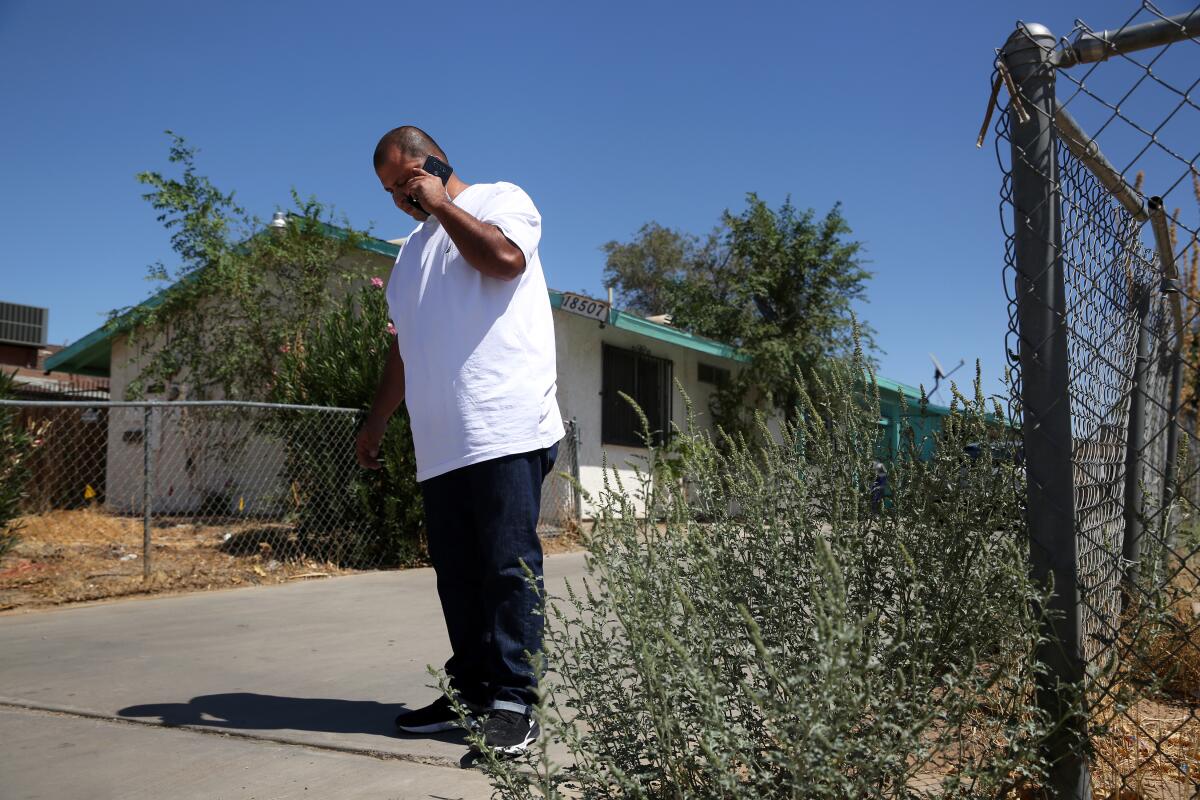
Three years ago, Domingo Nuñez was released from jail, following a couple decades of going in and out for felony car theft and other crimes. He found work repairing appliances and now has enough money for housing for himself, his partner and their three children — the two youngest with autism. But his search for housing in Hesperia, Adelanto and neighboring communities has been fraught with rejection.
“When you get to these places they’re like, ‘Crime-free, crime-free, crime-free,’” said Nuñez, 43. “I’m like, ‘What the hell is crime-free?’ And they’re like, ‘If you have a criminal background, we can’t rent to you.’”
Nuñez ended up at a duplex in Adelanto. But the place is filled with mold, and he’s had to throw out sets of living room and bedroom furniture because of bedbugs.
Occasionally, the septic tank overflows, forcing Nuñez’s family to bounce around hotels for weeks at a time. He’s not giving up his search for a new home.
“There has to be something else,” said Nuñez, who is Mexican American. “My kids deserve more. These little ones with special needs. They deserve a better place and I can’t give them a better place.”
More to Read
Sign up for Essential California
The most important California stories and recommendations in your inbox every morning.
You may occasionally receive promotional content from the Los Angeles Times.
